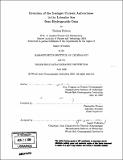Evolution of the Irminger Current anticyclones in the Labrador Sea from hydrographic data
Author(s)
Rykova, Tatiana
DownloadFull printable version (7.148Mb)
Other Contributors
Woods Hole Oceanographic Institution.
Advisor
Fiammetta Straneo.
Terms of use
Metadata
Show full item recordAbstract
The continuous supply of heat and fresh water from the boundaries to the interior of the Labrador Sea plays an important role for the dynamics of the region and in particular, for the Labrador Sea Water formation. Thus, it is necessary to understand the factors governing the exchange of properties between the boundary and interior. A significant fraction of heat and fresh water, needed to balance the annual heat loss and to contribute to the seasonal freshening of the Labrador Sea, is thought to be provided by coherent long-lived anticyclonic eddies shed by the Irminger Current. The population, some properties, rates and direction of propagation of these anomalies are known but the evolution and the mechanism of their decay are still far from obvious. In this work I investigated their water mass properties and evolution under the strong wintertime forcing using hydrographic data from 1990-2004 and a 1-dimensional mixed layer model. There were 50 eddies found in the hydrographic data record, 48 of which were identified as anticyclones. Vertical structure of the eddies was investigated, leading to the categorization of all the anticyclones into three classes: 12 - with a fresh surface layer and no mixed layer, 18 - without a fresh layer and at least one mixed layer, and 18 with ambiguous vertical structure. Four eddies of the second group appeared to have cores extending to as deep as 1500 m vertically and an isopycnal displacement of 400-600 m. A number of eddies without a fresh water cap contained Labrador Sea Water from the previous year at mid-depths. (cont.) Vertical structure of the eddies was investigated, leading to the categorization of all the anticyclones into three classes: 12 - with a fresh surface layer and no mixed layer, 18 - without a fresh layer and at least one mixed layer, and 18 with ambiguous vertical structure. Four eddies of the second group appeared to have cores extending to as deep as 1500 m vertically and an isopycnal displacement of 400-600 m. A number of eddies without a fresh water cap contained Labrador Sea Water from the previous year at mid-depths.
Description
Thesis (S.M.)--Joint Program in Physical Oceanography (Massachusetts Institute of Technology, Dept. of Earth, Atmospheric, and Planetary Sciences; and the Woods Hole Oceanographic Institution), 2006. Includes bibliographical references (p. 139-143).
Date issued
2006Department
Joint Program in Physical Oceanography; Woods Hole Oceanographic Institution; Massachusetts Institute of Technology. Department of Earth, Atmospheric, and Planetary SciencesPublisher
Massachusetts Institute of Technology
Keywords
Joint Program in Physical Oceanography., Earth, Atmospheric, and Planetary Sciences., Woods Hole Oceanographic Institution.